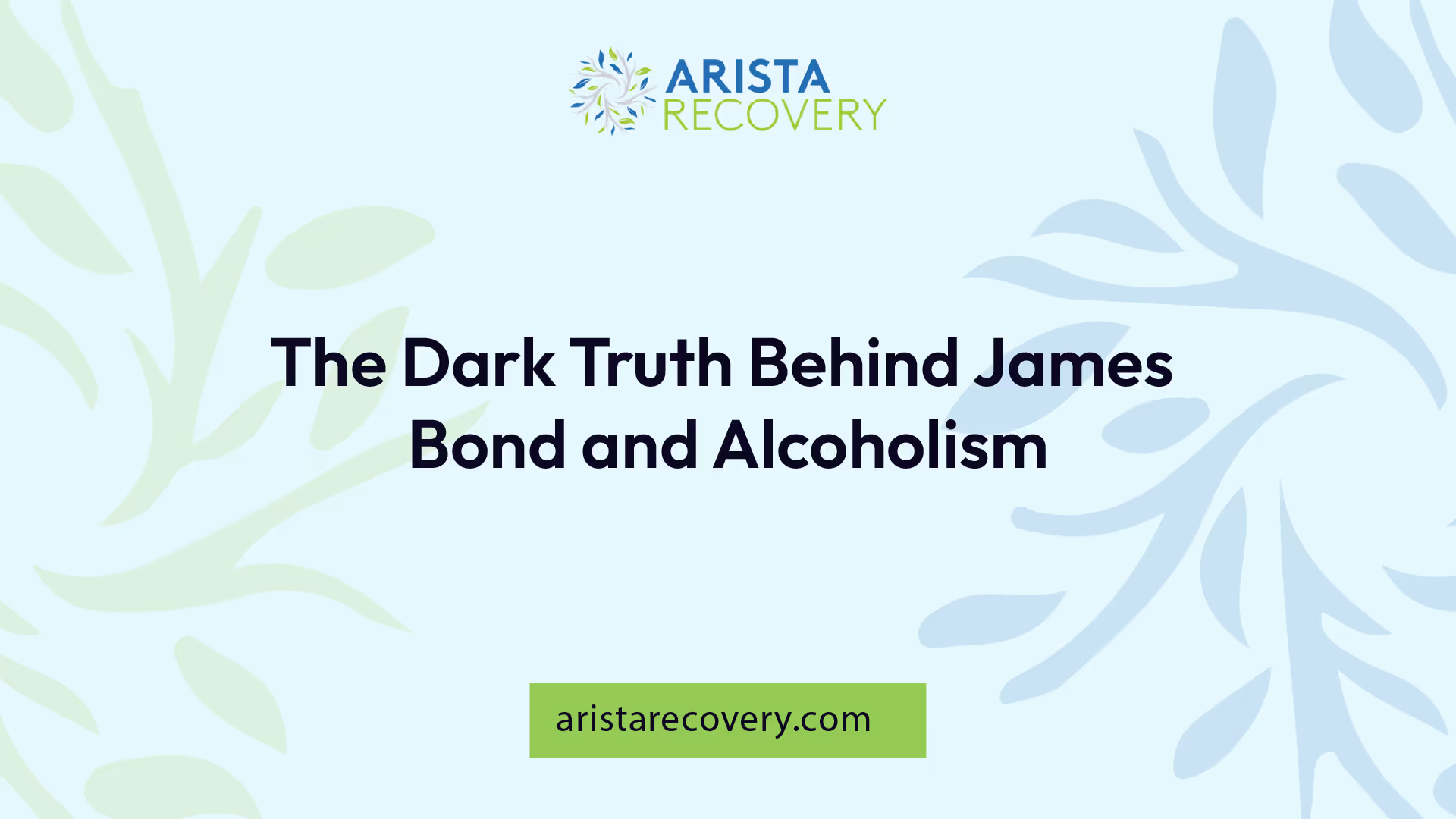The Dark Truth Behind James Bond and Alcoholism

James Bond's Alcohol Consumption
Alcohol Intake in Ian Fleming's Novels
In Ian Fleming's novels and short-story collections, James Bond's alcohol consumption was alarmingly high. On average, he consumed 92 units of alcohol per week over a total of 123½ days. This alarming figure translates to more than four times the recommended amount of alcohol intake. His maximum daily alcohol consumption reached 49.8 units, which places him at a significant risk for alcohol-related diseases.

MeasurementAmountAverage Weekly Alcohol Consumption92 unitsMaximum Daily Alcohol Consumption49.8 unitsRecommended Intake (UK NHS)21 units for men, 14 units for women
According to research, Bond's high-stress job as a spy likely contributes to his excessive drinking. The narrative details in Fleming’s works reveal a deeper reliance on alcohol as both a coping mechanism and a cultural indulgence.
Discrepancies Between Novels and Movies
The portrayal of James Bond in the films presents a stark contrast to his characterization in the novels. In the movies, Bond consumes significantly less alcohol compared to what is depicted in Fleming's original writings. Reports suggest that he consumes more than double the alcohol in the books than in the films [1].
SourceAverage Alcohol ConsumptionIan Fleming's Novels92 units per weekJames Bond FilmsLess than half of novel consumption
This discrepancy raises questions about the influence of movie culture on viewer perceptions of drinking. While the films maintain the iconic image of Bond as a suave drinker, they underplay the actual addiction portrayed in the original literature. This altered narrative may have significant implications for how audiences view alcohol consumption and lifestyle choices.
Overall, the characterization of James Bond's relationship with alcohol reveals a complex depiction of addiction and coping mechanisms, especially given the contrasting portrayals across different media.
Influence of James Bond on Viewers
The character of James Bond has long been synonymous with sophistication, adventure, and, notably, alcohol consumption. His portrayal in films has had a significant impact on viewer perceptions and behaviors related to drinking.
Alcohol Portrayal in Movies
James Bond movies often glamorize alcohol consumption, portraying it as an essential aspect of the character's lifestyle. This depiction can contribute to a romanticized view of drinking. Exposure to portrayals of alcohol in various media, including Bond films, has been linked to increased alcohol consumption.
The image of Bond enjoying cocktails in luxurious settings creates an allure that can shape how viewers perceive alcohol in their own lives. However, it is important to note that the portrayal of drinking in films does not always reflect real life. In reality, excessive alcohol consumption can lead to serious health and social consequences [2].
ElementImpact on ViewersGlamorous LifestyleNormalizes alcohol consumptionDrinking as CelebrationEncourages beliefs that drinking is essential in social settingsHeavy Drinking PortrayalMay lead to desensitization to dangers of alcohol
Effects on Audience Behavior
The portrayal of alcohol in James Bond films can influence audience behavior, particularly among younger viewers. Exposure to alcohol advertising and depictions of heavy drinking has been linked to increased drinking beliefs and behaviors among young individuals [3]. This may normalize and perpetuate dangerous patterns of alcohol consumption.
James Bond's excessive drinking may not only glamorize alcohol but also downplay the risks associated with it. The character's behavior poses a significant risk of developing alcohol-related diseases such as alcoholic liver disease and cirrhosis. The influence of such portrayals can lead viewers to underestimate the serious health risks posed by heavy drinking, impacting their own choices regarding alcohol consumption.
BehaviorPotential Audience ReactionImitation of Bond's DrinkingIncreased consumption in social settingsLack of AwarenessUnderestimation of health risksAcceptance of Alcohol as NormContributing to potential addiction scenarios
The impact of James Bond's character extends beyond entertainment, shaping perceptions and behaviors surrounding alcohol consumption among audiences.
Signs of Alcoholism in James Bond
Coping Mechanisms with Alcohol
James Bond often demonstrates a reliance on alcohol as a coping mechanism. This behavior is evident through his excessive consumption of alcohol in various situations, such as stressful encounters or personal turmoil. Such patterns symbolize a problematic relationship with alcohol, which he uses to manage emotional and situational stress [2].
Coping MechanismDescriptionSocial EventsEngages in drinking during social gatherings as a means of fitting in.Stress ReliefConsumes alcohol to relax after stressful missions or confrontations.Emotional EscapeUses alcohol to numb emotional pain or personal loss.
Behavioral Patterns and Consequences
Bond's drinking habits reveal several concerning behavioral patterns. His excessive alcohol consumption not only indicates a reliance on alcohol but also places him at a heightened risk of developing alcohol-related diseases, such as alcoholic liver disease and cirrhosis. Public health experts express concerns regarding the normalization of such patterns, particularly considering the impacts of exposure to alcohol advertising depicted in his movies.
A study published in the British Medical Journal calculated Bond's weekly alcohol intake at 92 units, which is over four times the recommended amount for an adult male [5]. This excessive consumption aligns with the troubling behavioral patterns displayed by Bond, which promote dangerous alcohol practices among audiences, particularly young individuals.
Behavioral PatternConsequencesHeavy DrinkingIncreased risk of developing alcohol-related health issues.DependencyPotential for addiction and difficulty in managing personal relationships.Impaired JudgmentPoor decision-making in critical scenarios, often leading to dangerous outcomes.
These behaviors not only shape the character of James Bond but also raise significant concerns regarding the portrayal of alcohol usage in popular media, leading to a need for increased awareness about responsible drinking practices.
Health Risks of Excessive Drinking
Excessive alcohol consumption carries numerous health risks that can develop over time. James Bond’s drinking habits in the movies and novels serve as a fictional yet striking example of these potential consequences.
Potential Diseases and Conditions
James Bond's weekly alcohol consumption has been reported to be between 65 to 92 units, which is significantly beyond the recommended maximum of 21 units for adult males according to the UK NHS. This excessive intake places him at a substantially higher risk for a variety of serious health issues, such as:
Disease/ConditionRisk DescriptionAlcoholic Liver DiseaseHigh risk due to chronic excessive drinking.Liver CirrhosisRelative risk ranges from 7 to 16 times that of abstainers. (BMJ)Other Alcohol-Related Health ProblemsIncludes an increased likelihood of multiple pathologies. (New Horizons Centers)Early DeathA study indicated Bond's drinking put him at high risk for early mortality due to alcohol-related diseases. (Washington Post)
Impact on Overall Health
The effects of Bond's drinking extend beyond immediate medical conditions. Chronic excessive drinking can lead to broader health consequences that significantly impact overall well-being. The high levels of alcohol consumption lead to numerous physiological changes and health risks, including:
Health ImpactDescriptionMental Health DeteriorationIncreased risk of anxiety, depression, and other mood disorders.Cardiovascular IssuesHigher chances of high blood pressure, stroke, and heart disease.Impaired Cognitive FunctionsPotential issues with memory, decision-making, and reasoning abilities.Addictive BehaviorsDevelopment of alcohol dependency and addiction.
Understanding these health risks highlights the dangers of emulating fictional characters, such as James Bond, who often romantically portray excessive drinking without reflecting the serious health consequences that accompany such behavior. The stark contrast between Bond's impressive feats and his hazardous drinking habits serves to emphasize the complexity of addiction and its repercussions on health.
Analysis of Drinking Patterns
Alcohol Intake Over Bond's Career
James Bond's alcohol consumption showcases a striking pattern throughout his fictional career as a spy. Analysis of his drinking habits across 12 of the 14 Ian Fleming novels reveals that he averaged 92 units of alcohol per week, significantly surpassing the UK National Health Service guidelines for adult males. This excessive intake places him at a high risk for health complications, including liver diseases and other alcohol-related issues.
Period of CareerAverage Units of Alcohol per WeekEarly Career70 - 90 unitsMid CareerDecreased, approx. 65 unitsLater CareerGradual increase, approx. 92 units
His drinking patterns indicate fluctuations, with a notable decrease mid-career, likely influenced by personal loss. However, his alcohol intake resumed increasing towards the end, particularly after the death of his wife. This suggests a possible relationship between significant life events and his drinking behavior.
Link Between Alcohol and Stress
The high-stress nature of Bond's job as a spy could contribute to his problematic alcohol consumption. Engaging in espionage involves significant pressure, danger, and emotional turmoil, which may lead to increased reliance on alcohol as a coping mechanism. With an average weekly alcohol intake ranging between 65 and 92 units, Bond's relative risk of severe health issues, including liver cirrhosis, is considerably elevated.
The connection between alcohol consumption and stress is well-documented. Heavy drinkers like Bond often consume alcohol as a way to alleviate pressure. His intake reflects consistent yet variable patterns typical of individuals with potential alcohol dependence. Across his missions, Bond's drinking fluctuated significantly, mirroring the behavior seen in many heavy drinkers who may resort to alcohol in times of high stress.
Alcohol Intake RangeRelative Risk of Liver Cirrhosis65 - 92 units7 - 16 times higher than non-drinkers
This data underscores the risks associated with excessive alcohol use, illustrating how Bond's lifestyle and emotional challenges may have driven his reliance on alcohol as both a comfort and coping strategy.
Bond's Functioning and Alcohol
Fiction vs. Reality
The character of James Bond is often depicted as capable of executing complex tasks with remarkable efficiency, even while consuming high levels of alcohol. However, studies indicate that this portrayal is largely fictional. James Bond's typical alcohol intake ranged between 65 and 92 units a week, significantly exceeding the recommended limits set by the UK National Health Service (NHS) [5].
Alcohol IntakeDescription65–92 units per weekAverage consumption for James BondUK NHS Recommended Limit14 units per week
This level of consumption would lead to considerable impairment in real life, affecting cognitive and physical abilities. Excessive alcohol intake is known to impair decision-making, coordination, and reaction times. Therefore, while Bond's high-functioning behavior may be entertaining and engaging as a cinematic trope, it does not accurately reflect the serious implications of such alcohol consumption in reality.
Implications of Heavy Drinking
The consequences of Bond's alcohol consumption highlight serious health risks. By consuming 65 to 92 units a week, he may face a relative risk of developing liver cirrhosis that ranges from 7 to 16 times higher compared to a lifetime abstainer [5]. Furthermore, the likelihood of facing other severe health conditions is also significantly elevated.
Health RisksRelative RiskLiver Cirrhosis7–16 times higherOther Serious PathologiesElevated
The implications are not only physical; the psychological toll related to alcohol dependency can be debilitating. James Bond's character, serving in a high-stress profession as a spy, reflects how such environments can lead individuals to unhealthy coping mechanisms, like excessive drinking. The blend of high-stakes scenarios and substance misuse paints a complex picture of how easily one can slide into alcoholism, emphasizing the need for awareness and understanding of addiction behaviors.
References
[2]:
[3]:
[4]:
[5]:
You’re not alone in this.
When mental health challenges and addiction intersect, it can feel isolating. At Arista, we offer compassionate, evidence-based, and trauma-informed care to help you heal, grow, and move forward.
You’re not alone in this.
When mental health challenges and addiction intersect, it can feel isolating. At Arista, we offer compassionate, evidence-based, and trauma-informed care to help you heal, grow, and move forward.
Support that moves with you.
You’ve taken a brave first step. At Arista Recovery, we’re here to help you continue with best-in-class care designed for long-term healing and support.
.webp)






